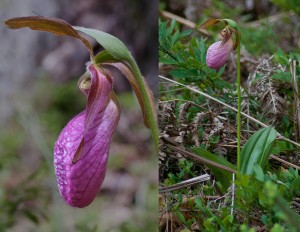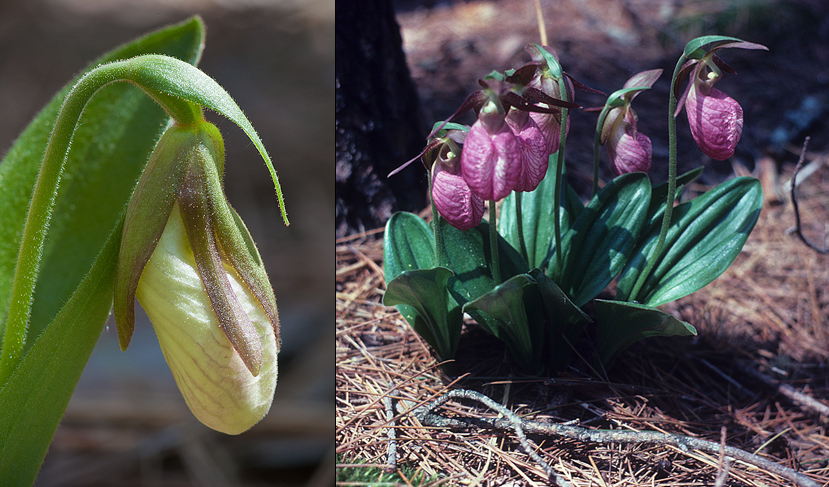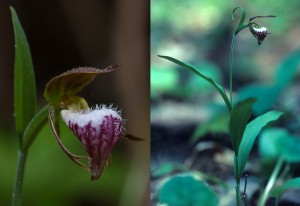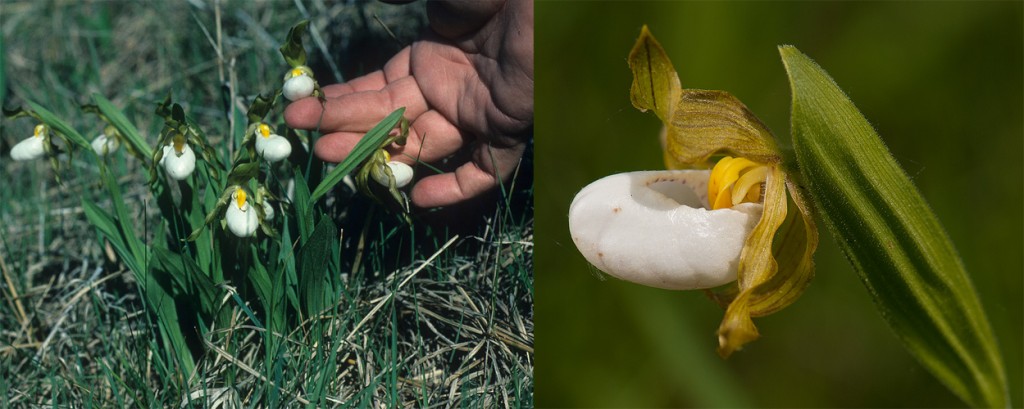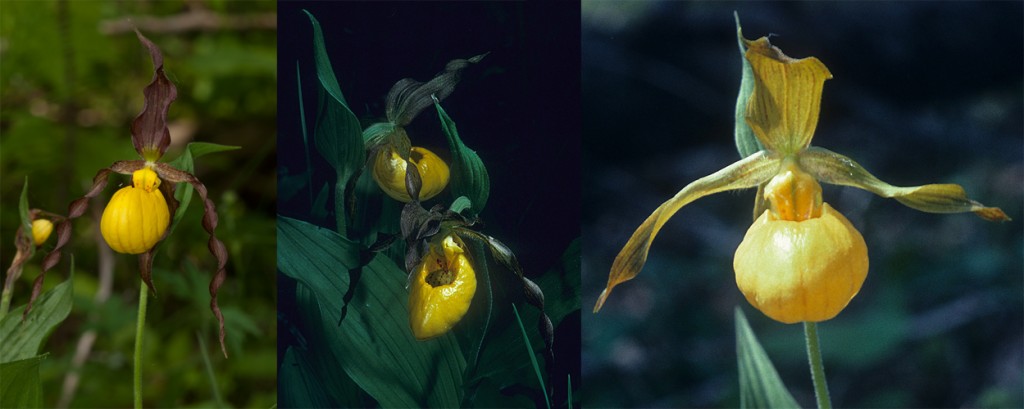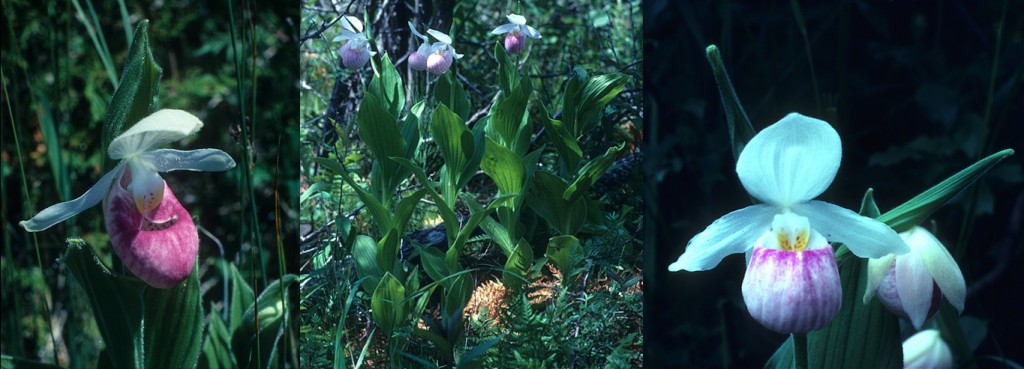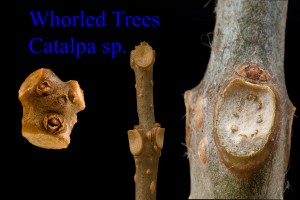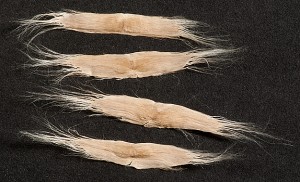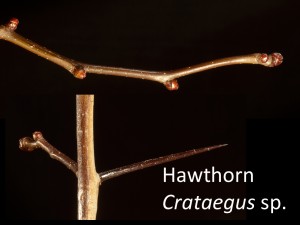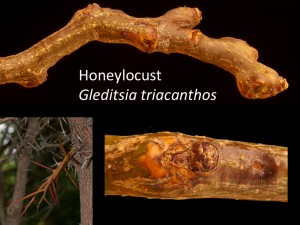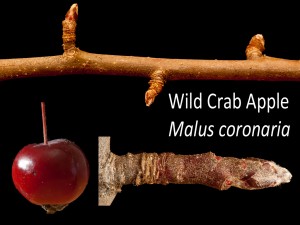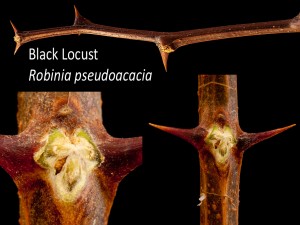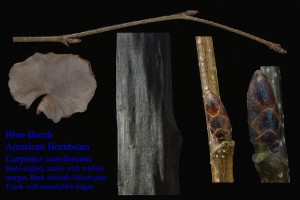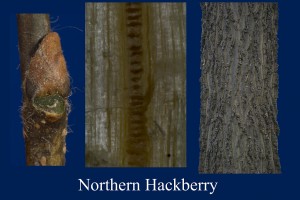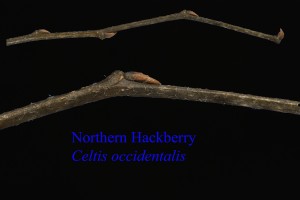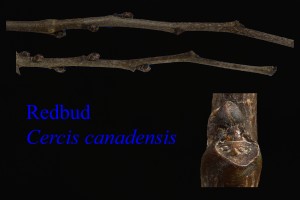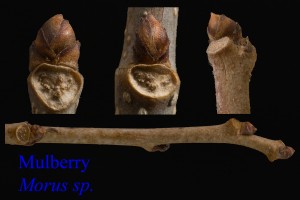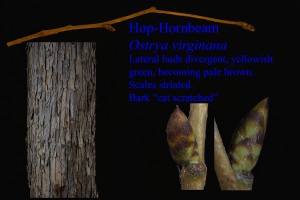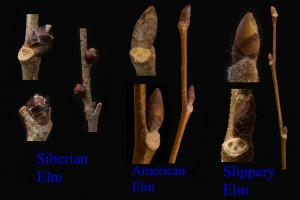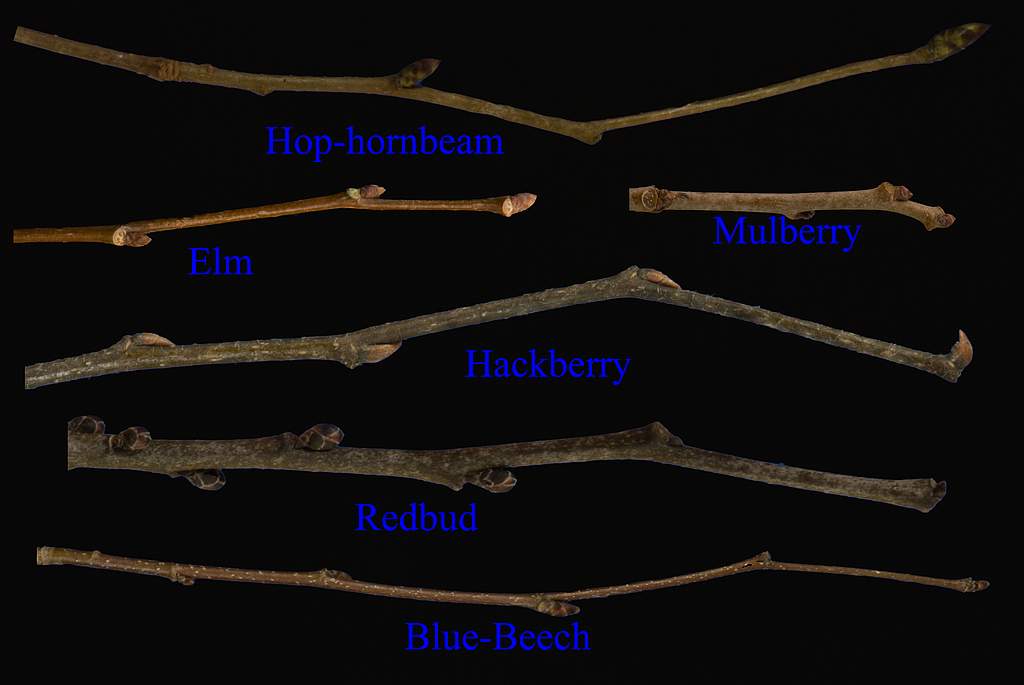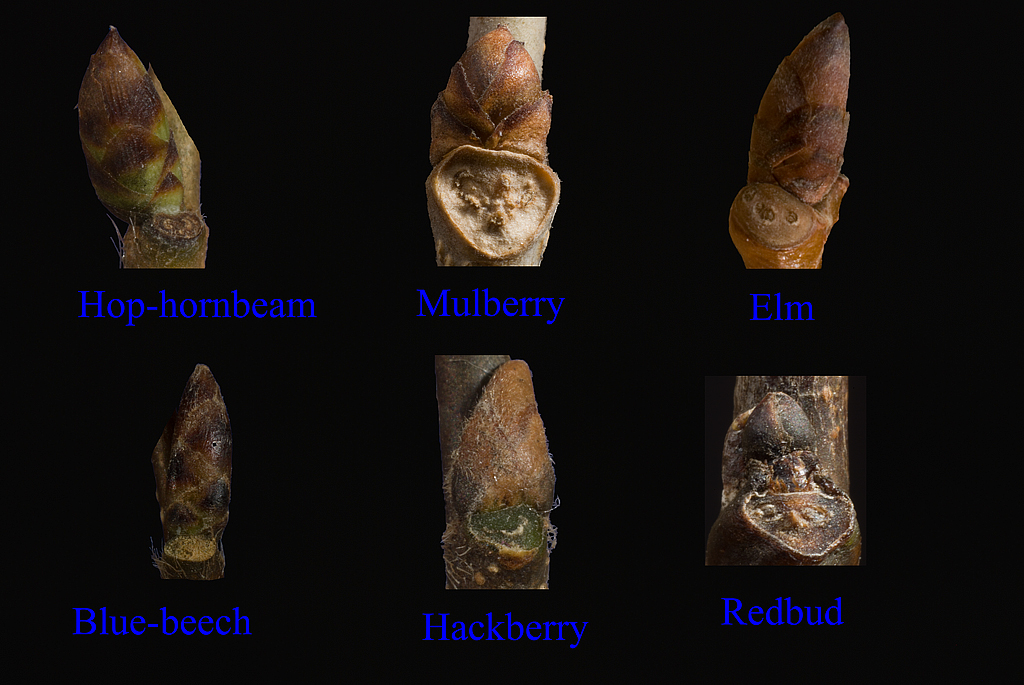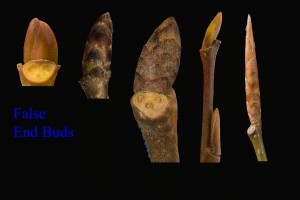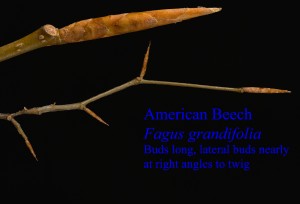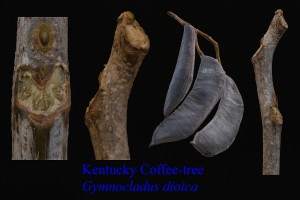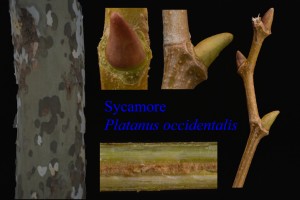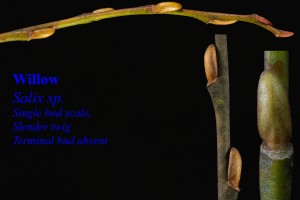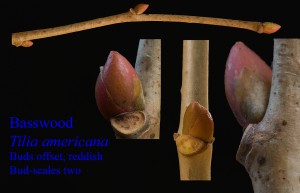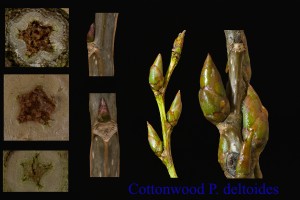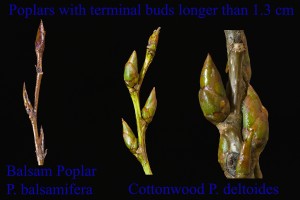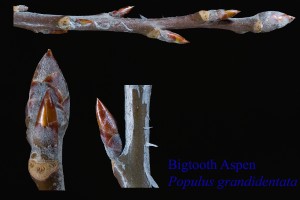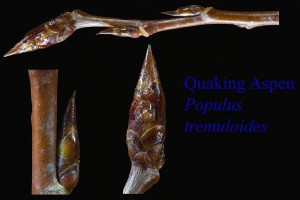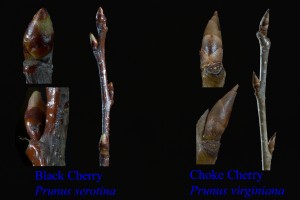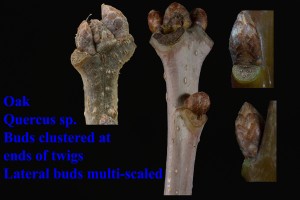The five species of Lady-slippers that grow in Michigan are some of our showiest wildflowers. They belong to the Orchid Family (Orchidaceae) and are in the genus Cypripedium. Cypripedium comes from Cypris meaning Venus and pedilon meaning shoe. Scientific names consist of two words. The first is the genus and the second is the specific name. Related plants are grouped in the same genus but have distinct specific names. Species are sometimes further broken down into subspecies, varieties, and forms. Our Yellow Lady-slipper has two varieties in the state, but it is difficult at times to distinguish them.
Stemless Lady-slipper (Cypripedium acaule), also called Moccasin Flower or Pink Lady-slipper, is a widespread acid loving plant. Acaule means stemless and refers to the leaves at the base of the plant. It flowers from late May and to the end of June. Normally the flowers are pink but white flowered plants and darker flowered plants occur. The flowers are cream-colored when they are developing and can be mistaken for albinos. It grows in the pine-needle duff around Grayling. Once we were looking for Moonworts (Botrychium spp) and stumbled onto several thousand lady-slipper plants blooming in a borrow pit. A borrow pit is a location were sand has been dug out for road construction. The area was less than an acre and the leaves of the plants touched each other.
Ram’s Head Lady-slipper (Cypripedium arietinum) grows in the Great Lake’s dunes or among the conifers at the edges of the dunes. Arietinum means like a ram’s head and the flower when looked at head on does resemble a head. The plant has a wiry stem that always seems to be moving in the breeze. It is a challenge to photograph this plant. Most recent records come from the Upper Peninsula and the Lower Peninsula north of Grayling.
White Lady-slipper (Cypripedium candidum) is found in fens or bogs in southern Michigan. Candidum means white. When I first saw this plant, I was surprised at its small size. The plant’s white lip has purple veins. This orchid loves sun and disappears where it is shaded. Several of the colonies I have observed for many years grow near railroad tracks and the fens burn periodically from fires caused by sparks from the railroad. Several colonies I know have been overgrown by Glossy Buckthorn (Frangula alnus [Rhamnus frangula]). One in Livingston County disappeared in five years. The first year several buckthorn seedlings grew among the flowering lady-slippers, by the third year the plants no longer flowered and were reduced to seedling like plants consisting of a single leaf. By the fifth year no plants could be located.
Yellow Lady-slipper (Cypripedium parviflorum) is found throughout Michigan and is highly variable. Parviflorum means small flowered. The species as now classified separates our plants from the European (C. calceolus) plants. The typical variety (var. parviflorum) occurs in the southeastern United States.
As a side note: when botanists name a new species of plant, they designate a “type specimen.” This is a single pressed plant that other botanists can study to determine exactly what the species is. The type specimen of a given species also establishes the typical variety that might not be the commonest variety. Therefore, the typical variety of the Yellow Lady-slipper is Cypripedium parviflorum var. parviflorum even though there are many more plants of the variety pubescens in the world. The variety pubescens (meaning pubescent) and variety makasin (from the Algonquin Indian name of this flower) both grow in Michigan.
Variety makasin has the common name Smaller Yellow Lady-slipper. In this variety the lip is small (the size of my little fingernail), the sepals and lateral petals are dark, it grows in bogs or fens in southern Michigan. This orchid is one of the sweetest smelling native plants with a strong scent similar to vanilla, another orchid.
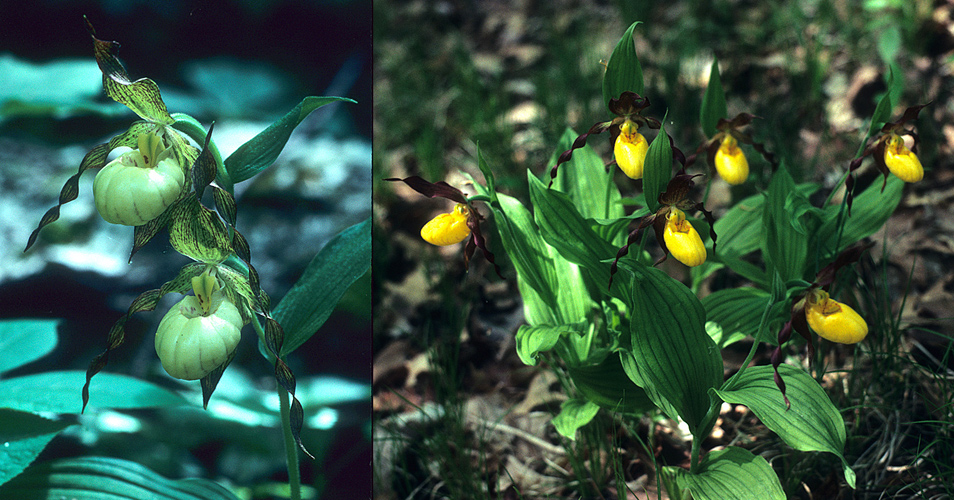
Yellow Lady-slipper
(L) Cypripedium parviflorum var.pubescens
(R) Cypripedium parviflorum var. makasin
The variety pubescens is normally large, its lip shape, twisting and color of the lateral petals, and habitat are extremely variable. The Yellow Lady-slippers growing farther north than Saginaw are this variety but it also grows in the southern part of the state. Small plants of this variety can be difficult to distinguish from var. makasin. In some plants, the lips are cream colored. These plants are found well north of the White Lady-slipper so they are not hybrids. They are just color forms. Plants can be as tall as two feet (.6 m).
Showy Lady-slipper (Cypripedium reginae) grows in wet areas throughout the state. Reginae means “of the queen.” The plants are two to three feet tall, with one to three, two-inch wide flowers. They are regal plants. Botanists possess large vocabularies of technical descriptive words, however; Merritt Fernald in the eighth edition of Gray’s Manual calls this plant “handsome,” and in the first edition, Asa Gray himself calls it “beautiful.”
The group of plants shown in the photograph grows in a ditch along U.S.2 in Michigan’s Upper Peninsula. I first observed the colony in 1973. I have never failed to find plants there but some years they are single leaves only a few inches long. When the trees grow up and shade the plants they stop flowering and gradually reduce in size. The power company clears the trees out of the ditch and within a year or two the plant bloom again. After five to ten years hundreds of plants flower in the ditch. As the trees grow up the number of flowering plants is reduced. Last year about a
dozen plants flowered. The trees were touching the power line so hopefully they will be cut soon.
I have watched another station for this plant almost as long. It grows in the Bald Mountain State Recreation Area in Oakland Co. When I first saw the colony in 1974, over six-thousand plants were flowering. It is in a large, cedar swamp. White-tailed Deer bedded down on grassy hummocks. When the deer population was high, they kept the White Cedar (Thuja occidentalis) browsed. When the deer population went down, the cedars grew up, shaded the plants, and they ceased flowering. The deer provide another service for the plant by stepping on their seedpods and planting the seeds. I revisited the colony a few years ago knowing that the deer population was high and expecting to see a lady-slipper show. I could only find a few single leaf plants. The cedar swamp was over-grown by Glossy Buckthorn (Frangula alnus). The colony is now gone.
An additional species, Franklin’s Lady-slipper (Cypripedium passerinum), occurs on the north shore of Lake Superior. It might one day be discovered in Michigan. I have often wondered if Oliver Farwell’s White Lady-slipper record in the 1880s from the Keweenaw was this species. His existing specimen is clearly White Lady-slipper but we know he replaced a few of his older specimens. I think he originally found Franklin’s Lady-slipper, identified it as White Lady-slipper because it was the only white-flowered lady-slipper in his botanical manual. Later he replaced the Franklin’s Lady-slipper specimen with the White Lady-slipper specimen that is the pressed plant we have today. Franklin’s Lady-slipper should be looked for in the Upper Peninsula. Who knows, one day, one of us may be walking alongside a cold northern Michigan stream…
Copyright 2013 by Donald Drife
Webpage Michigan Nature Guy
Follow MichiganNatureGuy on Facebook

